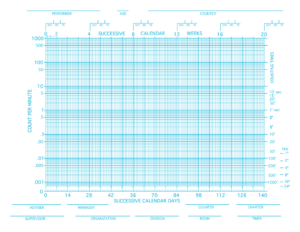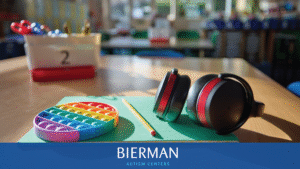Precision Teaching, to me, is a catalyst for accelerating a child’s progress. It is my greatest tool in my arsenal I use to produce socially significant changes. But now you may be asking what Precision Teaching is? In a recently published analysis of precision teaching, it is described as a system where you precisely define and measure behavior using continuous measurement procedures, mark data and analyze it on a standard celeration chart to make decisions that will effectively impact whatever it is you are trying to teach (Evans et al, 2020).
I use this system to implement strategies for teaching a child how to request their wants/needs, tell others what they feel, or learn to play with other peers. It can also be used to evaluate interventions to decrease challenging behaviors. Truly, use it in anything you are looking to promote functional and meaningful behavior for the child. Even in my real life I can use it to evaluate progress on the number of pushups I can do at one time.
Aside from the system itself, what sticks out to me most about precision teaching is based on the philosophy that “the learner is always right.” When things aren’t going the way we want it to, we don’t blame the child or the learner. We assess the environment and directions to make changes that will lead to the individualization the child needs to learn. Here at Bierman, we work really hard to ensure that our clients assent (or agree) to their program or we re-evaluate. If a learner engages in assent withdrawal (communicating that they do not want to participate or that something is too hard), we re-evaluate the program. Precision teaching allows us to design individualized goals and strategies that are in alignment to each family’s needs and future family goals. We are able to be a partner and build trust.

How it’s done
Let’s talk about how it’s done. Rick Kubina explains this in an easy to understand way: essentially the system can be broken down into 4 main parts: defining, measuring, analyzing the behavior and trying again until you get your desired results (Kubina, 2019). Let’s dive deeper into each of the components:
- Defining Behavior
When we define behavior in precision teaching, we are looking for the most concise and precise way to communicate what the behavior looks like and how to count it. For example, if we are working on a client’s spontaneous labeling during a play activity, we would note it as “see-say labels item with farm toy” or whatever that activity may be. It allows for those running the program to know exactly what it is we are looking for in the behavior of the client and what to count in their data.
- Measuring Behavior
In precision teaching, we like to measure and display behavior using continuous measurement procedures. What this means is that we collect data on the behavior that we are seeing for exactly what it is. Most times we are looking at the frequency of behavior, or how often a behavior occurs. By measuring behavior this way, it allows us to see if what we’re working on is making a socially significant impact. For example, we want to teach our kids the names of all the things around them, but we also want them to freely tell us what they see without hearing a cue such as “what is it?”. By using measurements that include the occurrence of behavior and time, it allows us to predict learning acquisition based on how long it takes the child to master current targets, which allows us to choose appropriate goals and set attainable expectations for the child.
- Analyzing Behavior
In order to analyze behavior, we must use a visual display. In precision teaching we use the Standard Celeration Chart. If we had the time, I would dive deeply into all the superpowers this chart has. However, I am going to attempt to keep it brief! The thing I like the most about the Chart is that no matter who the charter is or what type of data is going on it, it looks the same. The axes and ratio scaling are the same. Therefore we call it standardized. Just as we expect standardization in skill sets of medical licenses to the sizing on our clothes, we should expect standardization to the visual displays of our data. This is the home to visualize data and make data-based decisions. Just as our programs are individualized, our data-based decisions and programming changes are also individualized to meet the client where they are, but the chart remains the same. The other aspect I love about the chart is that it gives us learning pictures that we can use to predict future data and helps to facilitate the changes that we might make in a program. As you become more fluent in understanding the learning pictures, it facilitates faster programming changes which leads to finding the sweet spot in your intervention and propels the child’s progress forward.
Try again
Last but not least, the 4th step of precision teaching is to always try again. You continually use the system and make slight modifications to your intervention and program until the child is reaching the goals you and the family have set forth.
How is this integral at Bierman?
One of the core aspects of Bierman Autism Centers is that the learner is always right and that we treat them with kindness, integrity and respect. Our purpose is to accelerate progress by using data-based decisions- through precision teaching. Using a data-based approach with each child allows us to meet them where they are and provide them with care that is appropriate and purposeful.
Conclusion
Now, can Precision Teaching save the world? Most Likely. Can Precision Teaching with good instructional design save the world? Yes. Absolutely! But that can be a discussion for another day. If you are interested in learning more about Precision Teaching, please check out the resources below:
Resources:
A recently published article that analyzes where Precision Teaching is today: Evans, A. L., Bulla, A. J., & Kieta, A. R. (2021). The Precision Teaching System: A Synthesized Definition, Concept Analysis, and Process. Behavior Analysis in Practice. https://doi.org/10.1007/s40617-020-00502-2
A great resource for implementing Precision Teaching in your own practice: Kubina, R. M. (2019). The precision teaching implementation manual. Greatness Achieved Publishing Company.
The Daily BA on Youtube has many short videos and interviews with professionals in the field specific to PT. click here


